By Lynn McCain
The University of Michigan Department of Pathology was honored to serve as co-host of this year’s Association of Pathology Informatics Summit, held at Eagle Crest Resort in Ypsilanti, Michigan, May 20-23, 2024. Director of Pathology Informatics Dr. Ulysses Balis served as this year’s conference director, along with Henry Ford Health System’s Dr. Mark Tuthill, who served as co-chair, with incredible support provided by U-M's Beth Gibson, conference manager and CME coordinator, and the U-M Pathology Informatics team who dedicated hundreds of hours toward the planning of this meeting. This year’s Summit enjoyed an exuberant turnout, with nearly 400 in attendance. An overarching theme of the summit emphasized that while AI and Machine Learning use in pathology will continue to expand, the profession is in no danger of seeing pathologists and laboratory scientists being replaced by computer programs. Rather, these new tools will change workflows and enhance the level at which domain experts can operate, effectively elevating the overall level or practice in the field. Certainly, the need for skilled pathologists and laboratorians will persist.
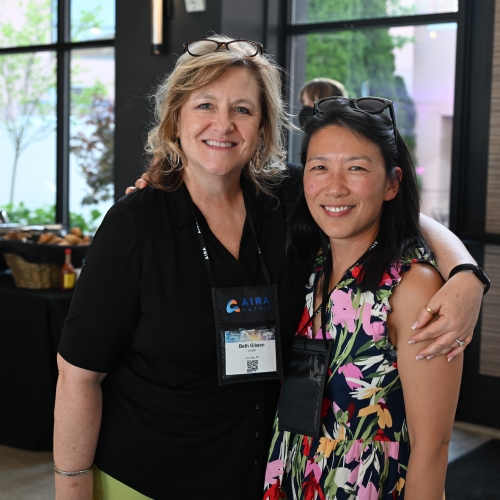
The Summit began with a pre-conference PI Summit Bootcamp, which provided foundational training on practical aspects of informatics, including: AI & machine learning, cybersecurity, genomics, technical and leadership skills, large language models, working across AP and CP, and demonstrating your value in the job search. This was followed by a Fellowship Fair in the evening.
The Summit presented such a wealth of information that it would be impossible to cover it all. As such, this overview will primarily focus on the presentations offered by those affiliated with our department. The Summit’s three concurrent tracks provided an extensive overview of the use of Artificial Intelligence and Machine Learning in Pathology.
Tuesday morning began with short abstracts being presented in three auditoriums concurrently, followed by three lecture tracks: Digital Pathology Deployment and Workflow, CP Operations, and PI Topics in Public and Global Health. Dr. Jacob Abel, former PI Fellow at the University of Michigan who is currently at Providence Health Services in Portland, Oregon, presented on Digital Pathology and Machine Learning in Molecular Genetic Pathology Workflow. He described the benefits of whole slide imaging (WSI), one of which is the ability to concurrently view H&E and unstained slides in a spatially synchronized fashion. Similarly, this technology offers improved ease of access by multiple individuals at any time and from any location, and the preservation of tissue blocks as made possible by needing fewer recut tissue sections. Workflows need to be carefully considered before integration. He then described a study on lung adenocarcinoma evaluating algorithms for evaluating tumor purity estimates. The algorithm performed slightly better than pathologists at 57% vs 50%. The goal, he indicated, is to be able to utilize digital identification as a first pass, which can then be fine-tuned to save time.
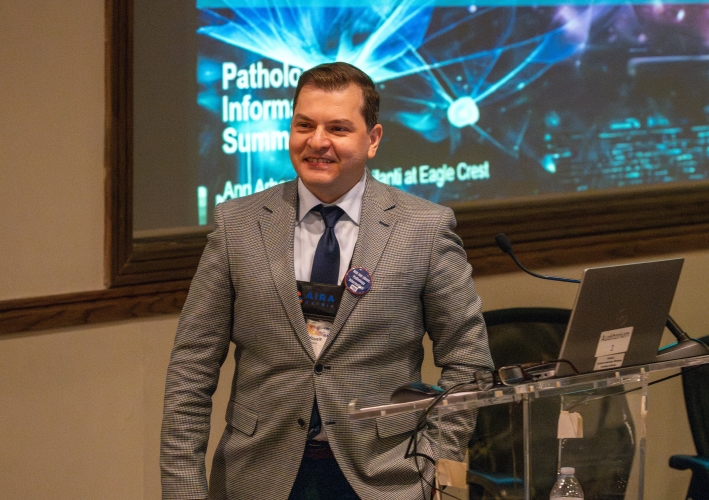 In addition to monitoring sessions, Dr. Mustafa Yousif, Assistant Professor and Director of Digital Pathology, presented Implementing Digital Pathology: A Strategic Plan for Transitioning to an Advanced Digital Pathology Workflow. In his presentation, he reviewed the journey that the Department of Pathology began in December 2022, with its goal of transitioning to all-digital primary diagnosis workflow, including the financial resources required for the needed hardware, facility renovations, software, storage needs, IT services, and personnel. He discussed the need to understand time-dependent workflow to be able to determine the total number of scanners needed and the importance of a lean lab layout to streamline workflows. Display dashboards were implemented to enhance communications and alert staff when slide staining was complete and when scanners were ready for loading/unloading. In addition, sign-out rooms needed to be reconfigured for ergonomic use of digital pathology with concurrent microscope and digital processes in place throughout the transition. Office updates were also needed with new workstations and monitors for digital pathology use only. He then proceeded to discuss the future state and the roll-out of the digital pathology service in the department. The talk was well received with a vigorous Q and A session following.
In addition to monitoring sessions, Dr. Mustafa Yousif, Assistant Professor and Director of Digital Pathology, presented Implementing Digital Pathology: A Strategic Plan for Transitioning to an Advanced Digital Pathology Workflow. In his presentation, he reviewed the journey that the Department of Pathology began in December 2022, with its goal of transitioning to all-digital primary diagnosis workflow, including the financial resources required for the needed hardware, facility renovations, software, storage needs, IT services, and personnel. He discussed the need to understand time-dependent workflow to be able to determine the total number of scanners needed and the importance of a lean lab layout to streamline workflows. Display dashboards were implemented to enhance communications and alert staff when slide staining was complete and when scanners were ready for loading/unloading. In addition, sign-out rooms needed to be reconfigured for ergonomic use of digital pathology with concurrent microscope and digital processes in place throughout the transition. Office updates were also needed with new workstations and monitors for digital pathology use only. He then proceeded to discuss the future state and the roll-out of the digital pathology service in the department. The talk was well received with a vigorous Q and A session following.
Tuesday afternoon offered plenary sessions moderated by Dr. Ulysses Balis. These sessions included Development and Explainability of AI Biomarkers in Histopathology Images (Dr. Beatrice Knudsen), Foundation Models and Information Retrieval in Digital Pathology (Dr. Hamid Tizhoosh), Applications of Large Language Mode Chatbots in the Clinical Practice of Pathology: A User Group Study (Dr. Simone Arvisais-Anhalt). After a break to browse the exhibits and poster sessions, the afternoon plenary sessions continued with Charting the Path: Navigating Patient Journeys through Digital Transformation (Dr. John Groth), and Adding Value with Pathology Informatics: Serving Healthcare’s New Consumers, New Care Models, New Payment Models, and More! (Robert Michel).
The afternoon concluded with the Diamond Exhibitor Presentation by Roche followed by a reception and team trivia game night. Women in attendance also enjoyed the Women’s Networking Nightcap.
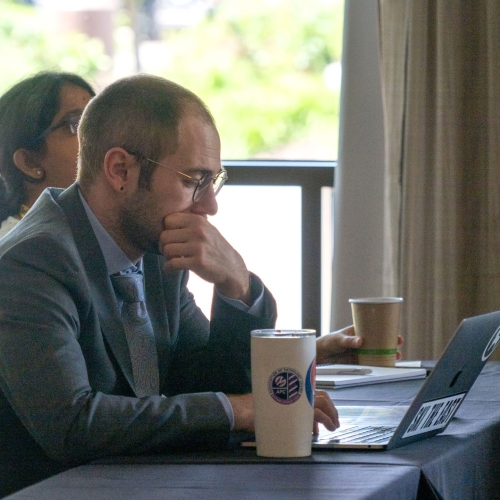 Attendees were back bright and early on Wednesday morning for more concurrently run short abstract presentations. Dr. Ryan Landvater, Neuropathology Fellow at U-M presented one of several abstracts, As Fast As Glass: A next-generation digital pathology rendering engine. He described the utilization of a program called “Iris” which allows for CPU serialized instructions, GPU parallel instructions in warps and waves, that uses VRAM and Pipe operations. Iris is not a computer application, but rather, an implementable solution that runs faster than any of the currently available software-based whole slide image viewer deployments. Such high-performance viewers are essential for enabling enormous digital slide files to be viewed clearly and without any lag by pathologists, creating fluid image movement as experienced by viewers with use of a microscope.
Attendees were back bright and early on Wednesday morning for more concurrently run short abstract presentations. Dr. Ryan Landvater, Neuropathology Fellow at U-M presented one of several abstracts, As Fast As Glass: A next-generation digital pathology rendering engine. He described the utilization of a program called “Iris” which allows for CPU serialized instructions, GPU parallel instructions in warps and waves, that uses VRAM and Pipe operations. Iris is not a computer application, but rather, an implementable solution that runs faster than any of the currently available software-based whole slide image viewer deployments. Such high-performance viewers are essential for enabling enormous digital slide files to be viewed clearly and without any lag by pathologists, creating fluid image movement as experienced by viewers with use of a microscope.
Following the abstract presentations, three concurrent morning track lectures were offered: AI, Machine Learning, and NLP in Molecular Pathology; Terminology, Standards, and Interoperability; and Contemporary PI Topics. Dr. Mustafa Yousif presented A Comprehensive Guide to PACS Acquisition, Vendor Evaluation, and Contracting a Request for Proposal Framework. He identified the critical factors for success as a clear description of current and desired workflows, active support from leadership, excellent project managers – both vendor and institutional, physicians with sufficient time over a lengthy period and knowledge to interact with vendors and provide feedback to the IT staff, a mature IT group, and active communications with colleagues and leadership. He indicated that he targeted those who were hesitant to become superusers of the system, which turned them into advocates.
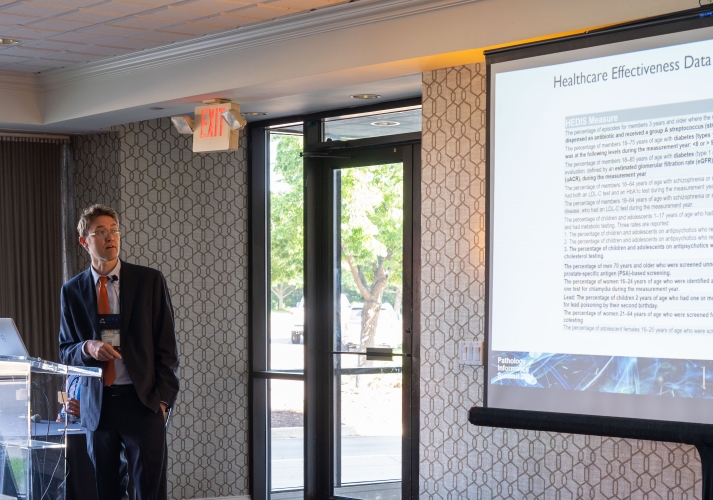 Wednesday afternoon continued with more concurrent lecture tracks including Generative AI Including LLMs, in Anatomic Pathology; AI, Including LLMs in Lab Medicine; and the Becich-Friedman Distinguished Oral Presentations. U-M Pathology was represented on Wednesday afternoon by Dr. Lee Schroeder, who presented Generating Reference Intervals from Secondary Data: The Case of Serum-Free Light Chains. As assays change, reference ranges may become out of date. Dr. Schroeder utilized indirect sampling of patients, using samples that were collected for purposes other than driving a reference interval, which is more representative of the general population. Starting with 63,000 results, he filtered and excluded patients who did not meet criteria until reaching a final cohort of 471 patients. This study indicated a reference range of .68 to 1.82 at 95% CI. Another prospective study found a range of .87 to 2.07. Both studies showed the reference range shifted to the right.
Wednesday afternoon continued with more concurrent lecture tracks including Generative AI Including LLMs, in Anatomic Pathology; AI, Including LLMs in Lab Medicine; and the Becich-Friedman Distinguished Oral Presentations. U-M Pathology was represented on Wednesday afternoon by Dr. Lee Schroeder, who presented Generating Reference Intervals from Secondary Data: The Case of Serum-Free Light Chains. As assays change, reference ranges may become out of date. Dr. Schroeder utilized indirect sampling of patients, using samples that were collected for purposes other than driving a reference interval, which is more representative of the general population. Starting with 63,000 results, he filtered and excluded patients who did not meet criteria until reaching a final cohort of 471 patients. This study indicated a reference range of .68 to 1.82 at 95% CI. Another prospective study found a range of .87 to 2.07. Both studies showed the reference range shifted to the right.
The afternoon concluded with a town hall, with extensive discussion the FDA’s decision on regulating laboratory developed tests. The API President’s address was introduced by outgoing president Dr. Ji Yeon Kim and incoming president Dr. Ronald Jackups. Mike Valante of Dell Technologies spoke on Data is the Fuel of Digital Healthcare, Mark Lloyd of Fuji Film talked about The Importance of a Pathology PACS, and Mike Rivers of Roche spoke on Accelerating Digital Pathology: The Power of Partnerships.
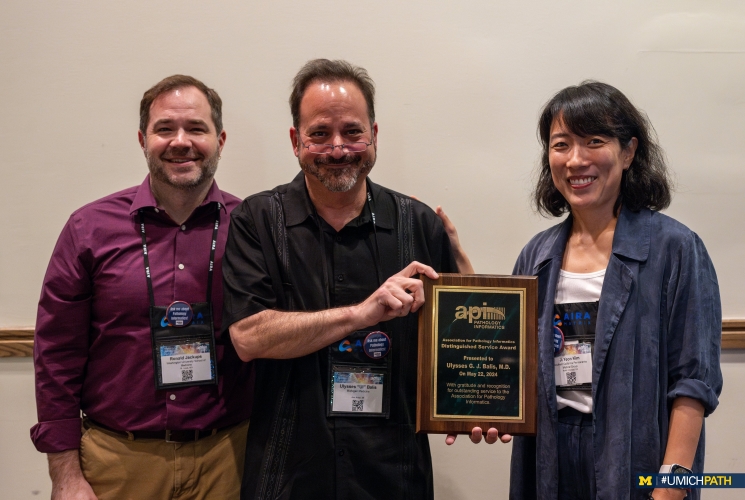 A Lifetime Achievement Award was presented to Dr. Mary Edgerton, Professor at UNMC Department of Pathology and Microbiology. Dr. Ul Balis, Professor and Director of Pathology Informatics at U-M was awarded the Distinguished Service Award. He has served as the alternating Conference Director or Co-director since 2014. Dr. Balis humbly accepted the award on behalf of the entire organizing group. The Becich-Friedman Distinguished Oral Presentations were recognized: Drs. Samer Albahra, Dibson Gondim, and Patricia Hernandez. Poster awards were presented to Drs. Daiki Taniyama (1st), Sulakshana Ranjan (2nd) and Chance Walker (3rd). Congratulations to all award winners! The awards presentations were followed by a reception and live music by Pathology’s own Lost in Processing band.
A Lifetime Achievement Award was presented to Dr. Mary Edgerton, Professor at UNMC Department of Pathology and Microbiology. Dr. Ul Balis, Professor and Director of Pathology Informatics at U-M was awarded the Distinguished Service Award. He has served as the alternating Conference Director or Co-director since 2014. Dr. Balis humbly accepted the award on behalf of the entire organizing group. The Becich-Friedman Distinguished Oral Presentations were recognized: Drs. Samer Albahra, Dibson Gondim, and Patricia Hernandez. Poster awards were presented to Drs. Daiki Taniyama (1st), Sulakshana Ranjan (2nd) and Chance Walker (3rd). Congratulations to all award winners! The awards presentations were followed by a reception and live music by Pathology’s own Lost in Processing band.
Thursday morning saw a thinner crowd but offered more excellent lectures on The Imminent Impact of Machine Learning and AI on LAB 2.0. Lisa-Jean Clifford presented Emerging Trends in LIS Architecture Design and Implementation to Enhance the Capture and Documentation of Value-Added Lab Services. Dr. Mark Tuthill presented Navigating the Transition to Value-Added Provisioning of Diagnostic Services: A Management Grimoire, Dr. Myra Wilkerson followed this with a presentation Envisioning Lab 2.0 Across and Between Health Enterprises and Robert Michel discussed Macroeconomic Trends in the Lab 2.0 Space. After a brief break, Dr. Annette Kim from U-M discussed What Now with Molecular Testing Following the FDA’s Final Rule.
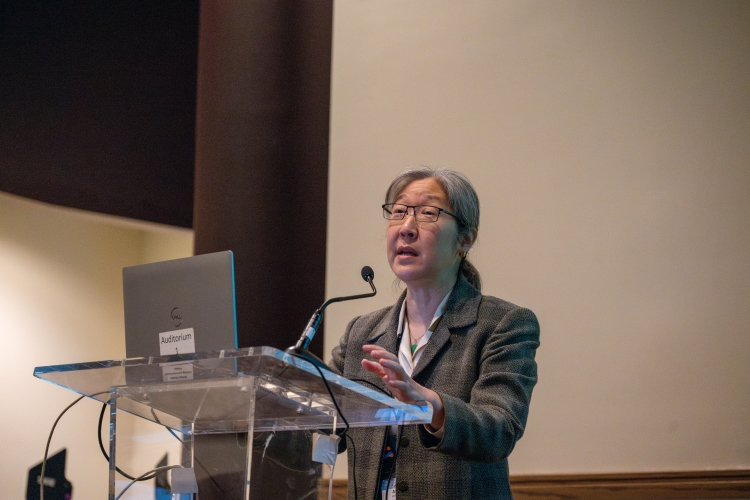 Dr. Kim reviewed the history of laboratory testing regulations, and the new policy as well as timing of implementation. Phase 1 goes into effect on May 6, 2025, with medical device reporting, correction and removal reporting, and quality system requirements. By the same date in 2026, registration and device listings, labeling requirements, and investigational requirements go into effect. By 2027, quality systems requirements will consider laboratories as manufacturers. As of November 6, 2027, premarket reviews of high-risk IVDs will be required, and by May 6, 2028, premarket review of medium and low-risk IVDs will be required. Exemptions include modified 510(k)s, which are modifications that do not affect safety or efficacy, or a change in intended use; unmet needs – but as soon as an IVD is approved by the FDA, it will no longer be considered an unmet need; any LDTs marketed prior to May 6, 2024 will be grandfathered in as long as it is not modified in any way after that date. There are multiple professional organizations considering litigation and Congress is being petitioned for a Congressional Review Act Resolution. If allowed to stand, there is significant concern about the ability of the FDA to approve these tests in a timely manner since there are 7,776 new tests annually and the FDA approved only 11 IVDs last year and only 144 genetic tests in its entire history.
Dr. Kim reviewed the history of laboratory testing regulations, and the new policy as well as timing of implementation. Phase 1 goes into effect on May 6, 2025, with medical device reporting, correction and removal reporting, and quality system requirements. By the same date in 2026, registration and device listings, labeling requirements, and investigational requirements go into effect. By 2027, quality systems requirements will consider laboratories as manufacturers. As of November 6, 2027, premarket reviews of high-risk IVDs will be required, and by May 6, 2028, premarket review of medium and low-risk IVDs will be required. Exemptions include modified 510(k)s, which are modifications that do not affect safety or efficacy, or a change in intended use; unmet needs – but as soon as an IVD is approved by the FDA, it will no longer be considered an unmet need; any LDTs marketed prior to May 6, 2024 will be grandfathered in as long as it is not modified in any way after that date. There are multiple professional organizations considering litigation and Congress is being petitioned for a Congressional Review Act Resolution. If allowed to stand, there is significant concern about the ability of the FDA to approve these tests in a timely manner since there are 7,776 new tests annually and the FDA approved only 11 IVDs last year and only 144 genetic tests in its entire history.
This excellent summit wrapped up with a panel discussion Q & A session and prize drawings. Next year, the API Summit will once again be held at Eagle Crest Resort on May 19-22, 2025. You don’t want to miss it!
